- Home
- Jack Kerouac
The Unknown Kerouac
The Unknown Kerouac Read online
THE UNKNOWN KEROUAC
RARE, UNPUBLISHED & NEWLY TRANSLATED WRITINGS
Todd Tietchen, editor
Jean-Christophe Cloutier, translator
THE LIBRARY OF AMERICA
Volume compilation, introductions, notes, and
chronology copyright © 2016 by Literary Classics of the
United States, Inc., New York, N.Y.
All rights reserved.
No part of this book may be reproduced in any manner whatsoever without
the permission of the publisher, except in the case of brief
quotations embodied in critical articles and reviews.
Distributed to the trade in the United States
by Penguin Random House Inc.
and in Canada by Penguin Random House Canada Ltd.
LIBRARY OF AMERICA, a nonprofit publisher, is dedicated to publishing, and keeping in print, authoritative editions of America’s best and most significant writing. Each year the Library adds new volumes to its collection of essential works by America’s foremost novelists, poets, essayists, journalists, and statesmen.
Visit our website at www.loa.org to find out more about Library of America and to explore our popular Story of the Week and Moviegoer features.
Library of Congress Control Number: 2016934976
ISBN 978–1–59853–498–6
eISBN 978–1–59583–499–3
CONTENTS
Editor’s Introduction
Translator’s Note
On Frank Sinatra
America in World History
A Couple of Facts Concerning Laws of Decadence
On Contemporary Jazz—“Bebop”
Private Philologies, Riddles, and a Ten-Day Writing Log
The Night Is My Woman [La nuit est ma femme]
Journal 1951
Old Bull in the Bowery [Sur le chemin]
Tics
Memory Babe
Doing Literary Work: An Interview with Jack Kerouac
Beat Spotlight
Appendix: I Wish I Were You
Chronology
Note on the Texts
Persons Mentioned
Notes
Special thanks to John Sampas,
literary executor of the Kerouac estate,
for the many ways in which he supported this project.
The Unknown Kerouac:
Rare, Unpublished & Newly Translated Writings
is published with support from
THE FLORENCE GOULD FOUNDATION
EDITOR’S INTRODUCTION
THE writings that follow offer a substantial and vital enlargement of the Jack Kerouac canon, tracing the growth of his voice and vision and giving a fresh sense of the wellsprings of his literary art. Hitherto unexplored pieces in a moving and impressive chronicle of aesthetic development, they deepen our understanding of Kerouac’s artistry and his evolution as one of the twentieth century’s most adventurous writers. These works, which span the course of Kerouac’s authorial life, attest to his aspiration to become an enduring American writer—an aspiration that drove him to reimagine the perspectives and cadences of American literature.
Kerouac transformed the materials of his life into a work of art realized across a multiplicity of genres and categories—letters, journals, poetry, novelized prose, and mongrel modes of experimentation juxtaposing and blending these forms. He was a tirelessly prolific and relentlessly ambitious writer, at what often proved a significant personal cost. The writings collected in this book will become indispensable to future appreciations of Kerouac’s work, prompting reconsideration of much that has been taken for granted about the intentions and scope of his accomplishment.
Many readers discover Kerouac through On the Road (1957), the signature work that seems to position its author as the generational voice of young people breaking free of their inherited past for the immensities of experiential possibility in Cold War America, hitting the road in a literal and figurative escape from crumbling moral conventions and mores. That is, in brief, the Kerouac myth. It has proven particularly hardy; and as myths are apt to do, it foregrounds one aspect of its subject at the expense of others. Kerouac himself resisted the myth. It becomes clear, for instance, from Beat Spotlight—an incomplete scroll manuscript Kerouac labored over during the final year of his life—that he came to lament the literary notoriety that followed the publication of On the Road, apprehensive that his name had become synonymous with aimlessness, irresponsibility, and criminality. Despite his dedication to the confessional and autobiographical, Kerouac died fearing that he had somehow remained unknown to critics and the reading public.
The Unknown Kerouac presents a more robust Kerouac. In the light of these newly available texts, On the Road can be seen as something more than a testament to unadulterated freedom and experiential journeying. In the wake of World War II, Sal Paradise and Dean Moriarty—the novel’s dual protagonists based respectively on Kerouac and his close friend and muse Neal Cassady—find themselves torn between the comforting promises of domesticity and their desire to flee conventional visions of the American good life for destinations less certain. Again and again, Sal attempts to slide out of his circumstances and into the possibilities of new experience on the road, into the new intensities that Dean heralds. Yet Sal also backtracks onto more predictable paths, into territories already settled. On the Road provides a detailed literary sketching of a generation torn between orthodoxies and unconventionalities, sentimental flirtations with nostalgia and optimistic longings for a world newly pried open.
Sal and Dean inhabit existential predicaments that Kerouac had already articulated in the holograph essays from the 1940s included here, composed while he was living in New York. Kerouac had moved to New York in 1939 from Lowell, Massachusetts, to attend Columbia University and play football—although his admission to Columbia required that he spend an additional year of preparatory work at the Horace Mann School. A talented athlete who also excelled in track and field and in baseball, Kerouac had harbored artistic hopes since his early teenage years. New York bohemian and jazz culture nourished those aims, as did his relationships with Allen Ginsberg, William Burroughs, Lucien Carr, and other members of the nascent Beat orbit revolving around Columbia. In this heady environment—an environment detailed in I Wish I Were You (1945), included here as an appendix—the animating conflicts and characteristics of Kerouac’s work began to take shape.
In the early essays that open this collection, Kerouac hovers somewhere between despair and triumphalism, seeking a common cultural ground with his generation while retaining his sense of being an outsider. In “On Frank Sinatra,” he identifies the “profundity of feeling” evident in the crooner’s voice as expressive of the mood of “loneliness and longing” experienced by young men during and after World War II. At times, those longings take on positive hues, as in “America in World History,” an affirmative essay in which Kerouac proclaims himself affiliated with his “American brothers” who as yet feel “young and unfulfilled,” poised to seek a cultural destiny distinct from the ossified traditions of Europe. Such generational optimism also infuses “On Contemporary Jazz—Bebop.” Elsewhere, however, Kerouac retreats into nostalgia, as in “A Couple of Facts Concerning Laws of Decadence,” where couched within a critique of city intellectuals is a devotion to “lineal heritage” stirred by a “liberal” New York radio skit.
The tensions between these opposing perspectives would continue to resonate through Kerouac’s writing. In the midst of his quest for the new, he often felt the pull of more familiar and consoling harbors. The allure of the quest coexists with what ultimately proves an unresolvable desire to feel rooted. Kerouac’s is a literature of roots and ro
utes. Jean-Christophe Cloutier’s translations of The Night Is My Woman and Old Bull in the Bowery—two narratives from the early 1950s originally composed in the French patois of Lowell’s Québécois working class, as La nuit est ma femme and Sur le chemin respectively—bear out the crucial significance of Kerouac’s roots in the French-Canadian culture of twentieth-century New England. Both works fill important gaps in Kerouac’s autobiographical aesthetic, the multivolume project he outlined in his preface to Big Sur (1962) as the Duluoz Legend, greatly augmenting the ethnography of French-Canadian life contained in the Lowell trilogy consisting of Visions of Gerard (1963), Doctor Sax (1959), and Maggie Cassidy (1959). The genealogy of the Duluoz clan’s migratory history from Québec into New England, as related in Old Bull in the Bowery, is an especially valuable addition.
Michel, the narrator of The Night Is My Woman, remains, like Kerouac, split down the middle. Michel discloses, “I’m all mixed up in my noggin,” ensnared within his desire to write in his native French, while at the same time harboring literary ambitions sparked by American writers such as Twain and Melville, and “their large form which was free and magnificent.” While known to generations of readers through the all-American moniker “Jack,” the writer was born Jean-Louis Kérouac in March 1922 in Lowell to native Québécois parents, Joseph Alcide Leon Kérouac and Gabrielle-Ange Lévesque. His father, who went by the name of Leo, had been born in Saint-Hubert, Québec, then immigrated with his family to Nashua, New Hampshire. Kerouac’s mother, Gabrielle, was born in 1895 in Saint-Pacôme, Québec, and her family also migrated to Nashua. The married Kerouacs settled among the sizable French-Canadian community of Lowell in order to raise a family in a setting in tune with more familiar ways of life. The ultimate distillation of the life of this family can be found in the affecting childhood memoir Memory Babe, begun in 1957 and published here for the first time.
Kerouac’s restlessness, his interest in road-bound and freight-bound outsiders, was partly grounded in his experience of the French-Canadian diaspora and the imperatives that often sent his own family on the road. Kerouac’s portrayals of French-Canadian life in The Night Is My Woman and Old Bull in the Bowery put his interest in migration or journeying in a more nuanced light. In both texts we meet characters who take to the road not for raw and unmoored adventuring for its own sake, but for the economic motives that send Michel trekking back and forth between Lowell and Portsmouth, or send the Kerouac family to New Haven seeking work, or send the Depression-era Pomerays racing desperately for New York. As many of the works included here make clear, his creative impulses always tapped into something much deeper than the youthful search for kicks.
Kerouac has long been seen as an impetuous writer, impulsively following his instincts wherever they might take him on the page, just as his characters seem to wander aimlessly, without governing principle. Such characterizations fail to take into account the artistic goals expressed, notably, in the document published here as Journal 1951, the record of a psychic and aesthetic breakthrough that transformed Kerouac’s sense of his mission as a writer. Here, Kerouac makes clear his commitment to creating a literature of lived experience, an expansive body of writing made from the events of his life. Later, in his June 1963 epistolary exchange with John Clellon Holmes (printed here for the first time), he would identify his time in the Veterans Hospital, where the journal begins, as pivotal in his development, observing that “I had time to think at last without interruption and unfolded my secret desire in writing at last.”
True to his aims, there appears to be nothing of literary contrivance about this journal. Kerouac’s writing here pulses and breathes. When Kerouac is at his best he allows us to partake in his dawning realizations, his wonderment and uncertainties. We get it pure, as Kerouac goes back and forth between sudden bursts of literary confidence and mountainous doubt—between illumination and the psychic pain that often sends him spiraling into demoralizing binge drinking. We share those vacillations with him in a way that feels profoundly true.
Journal 1951 enacts the literary principles it espouses. It is one of Kerouac’s most impressive accomplishments, its jewel-like complexities finally tapering into the fine point of its epilogue. Strikingly, Kerouac gains much of his insight while remaining still, lying on his back convalescing in the Kingsbridge VA hospital after an attack of thrombophlebitis. He stresses this correlation between his convalescence and his growing sense of himself as a literary artist, telling us at one point: “Though I’m writing this on my back I feel again like my own giant.” As he prepares to leave Kingsbridge he further admits “this is my last day in the Hospital where I have learned at last to think,” going on to say that “the solution of my lifework I attribute to the month of pure meditation in the hospital and thank God for it.”
Much has been made of the critical role played by Kerouac’s journals in allowing him to write while he was on the go, traveling across the states and beyond. The sedentary meditations of Journal 1951 provide a valuable contrast with Kerouac’s road journals, efforts represented here by Private Philologies, Riddles, and a Ten-Day Writing Log, a notebook whose hybrid contents reflect Kerouac’s peripatetic life as he traveled from New York to Denver and back in 1949 and 1950. Notably, Private Philologies features an extended engagement with Chaucer, including the passage from the Prologue to The Canterbury Tales in which Chaucer evokes the springtime stirring in the blood that sends people pilgrimaging through the world. Not only is this allusion perfectly at home among the searching experiments of Kerouac’s road-worn journal, but it shows that his interests in migratory experience and road narrative have as much to do with long-standing literary archetypes of pilgrimage and quest as they do with the longings of the postwar period, or the history of the French-Canadian diaspora. Allusions such as this abound here and usher us tellingly into the remarkably diverse, and as yet unappreciated, sources of Kerouac’s literary art. In Journal 1951, Kerouac baldly declares: “It is necessary for me to prove I’m a great writer.” Writers such as Joyce, Dostoevsky, Melville, Proust, and Céline provided models for Kerouac’s ambitions. The lifework of each developed across an expansive breadth that Kerouac clearly hoped to emulate—and ultimately did.
In his introductory comments to “Doing Literary Work: An Interview with Jack Kerouac,” John Clellon Holmes explains that his exchange with Kerouac was motivated by the sense that “proper justice” had yet to be done to Kerouac’s “essential gravity and dedication as a writer.” Kerouac’s discipline, as captured in Journal 1951, the act of willing himself toward a lifework of epic proportions, gives the lie to persistent characterizations of his art as purely intuitive and spontaneous. Much as Kerouac himself had done in Beat Spotlight, Holmes worries that the easy identification of his friend as the “King of the Beats” had obscured the arc of Kerouac’s achievement, suppressing his “stubborn fidelity to his own purchase on the truth.” Holmes feared that Kerouac had become ensconced in the public imagination as a reductive caricature of himself, a literary Marlon Brando iconized as ill-mannered, insubordinate, and lacking in artistic principles. In many ways, I have approached the editing of this collection in the spirit of Holmes’s concerns.
Kerouac left behind a sprawling, multiform, and multigenre chronicle of his life, much of it unpublished at the time of his death. His dedication to preserving his work has proven indispensable to our evolving comprehension of his accomplishments. The writings in The Unknown Kerouac have distinctive shadings and charismatic allures that further enrich our understanding of who he was. The longings and conflicts manifest in his work from its inception could never be truly resolved. True to his abiding aims, Kerouac handled those dilemmas through the unyielding devotion to candor on display here.
Todd Tietchen
University of Massachusetts at Lowell
TRANSLATOR’S NOTE
AFTER the attack on Pearl Harbor in December 1941, a nineteen-year-old Jack Kerouac went out into the “clear dead cold of New England winter”
at 2 A.M. to look for “the eye of the war.” Young Jack was home for the holidays in Lowell, Massachusetts, shortly after quitting Columbia University, and he recorded this nocturnal trek in the story “Search by Night.” The narrator enters an old lunchcart in Lowell’s factory district and orders a hamburger, the only thing, he happily declares, that can “satisfy a hunger in yourself which is exclusively and completely American.” As the “juicy mess” lavishes his palate, a few nightshift factory workers enter the lunchcart and interrupt his thoughts with their “vulgar and ugly jargon called New England French-Canadian.” “Ernest, Calvert, ’tara pas une chris de chance—! Ha ha ha!” one of the men says, and the other replies, “Héh Batêge!—Ha! Ha ha ha ha!”1 With remarkable insight into the profound mutilation this “jargon” has endured to survive on foreign soil, Kerouac describes their speech as “tormented, twisted, severed French.” Disgusted by these louts, Kerouac watches them “prattling incoherently, half of the time in coarse and obscene N.E. French-Canadian, half of the time in rowdy, faulty English.” The two men, he writes, switch “quickly, effortlessly” between the two languages. “This,” Kerouac instructs the reader, “is the language of the New England French Canadian, who is the rarest animal in the various N.E. mill cities, who is the bawdy, rowdy, gustful, and obscene inhabiter of crude wooden tenements, infestor of smelly barrooms along infamous slum streets, crude-handed laborer of factory, ditch, and field.” He goes on to qualify their broken English—phonetically rendered by Kerouac (e.g., “de fella wid de new Cad’lac”)—as “heavily, ponderously accented, almost idiotic.”.2
What this narrator—this Jean-Louis Kérouac—never tells the reader is that it might as well be a scene from his family’s dinner table. Kerouac is, in fact, describing himself. Or rather, at nineteen, he is desperately trying to distance himself from the “animal-like crudeness” of the race canadienne-française to which he belongs.3 In this early story, we can detect a logic behind his subsequent mastery of English: to never sound so “rowdy, faulty” and “idiotic” in America again. There is almost a sense that, if he eats enough hamburgers—he eats two in the seven-page story—he may finally become “exclusively and completely American.” Through such scenes, Kerouac notably renders in written form a type of French that, at the time, only existed as speech.

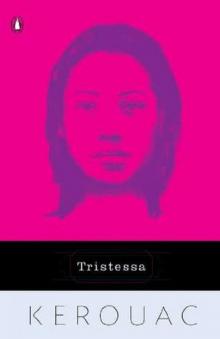 Tristessa
Tristessa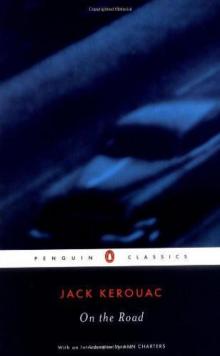 On the Road
On the Road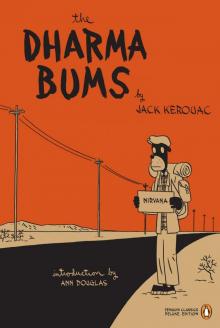 The Dharma Bums
The Dharma Bums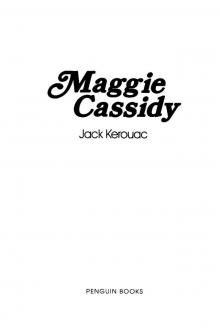 Maggie Cassidy
Maggie Cassidy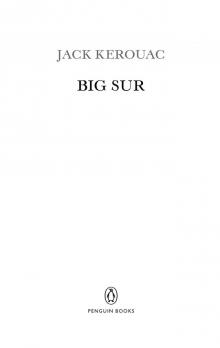 Big Sur
Big Sur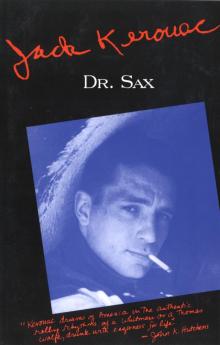 Dr. Sax
Dr. Sax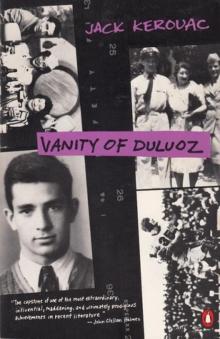 Vanity of Duluoz: An Adventurous Education, 1935-46
Vanity of Duluoz: An Adventurous Education, 1935-46 The Sea Is My Brother
The Sea Is My Brother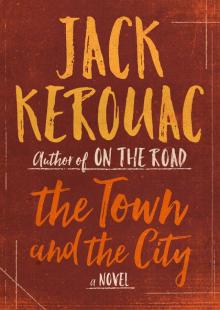 The Town and the City: A Novel
The Town and the City: A Novel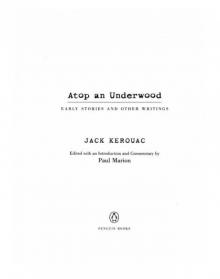 Atop an Underwood: Early Stories and Other Writings
Atop an Underwood: Early Stories and Other Writings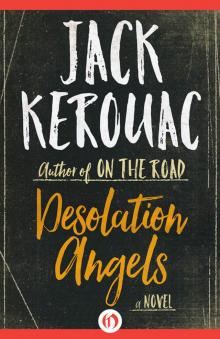 Desolation Angels: A Novel
Desolation Angels: A Novel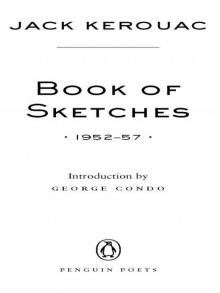 Book of Sketches
Book of Sketches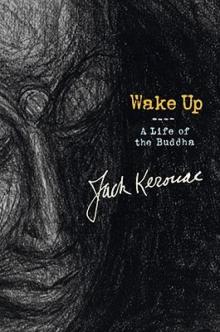 Wake Up: A Life of the Buddha
Wake Up: A Life of the Buddha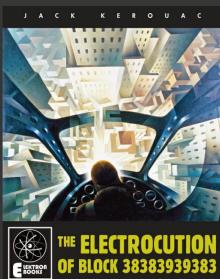 The Electrocution of Block 38383939383
The Electrocution of Block 38383939383 Haunted Life
Haunted Life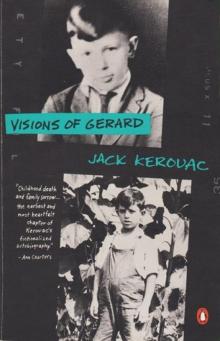 Visions of Gerard
Visions of Gerard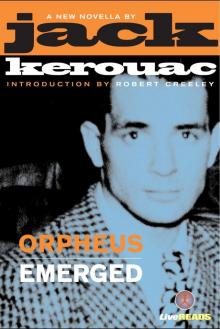 Orpheus Emerged
Orpheus Emerged Book of Blues
Book of Blues The Subterraneans
The Subterraneans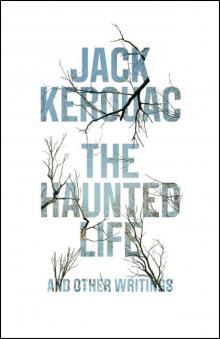 The Haunted Life
The Haunted Life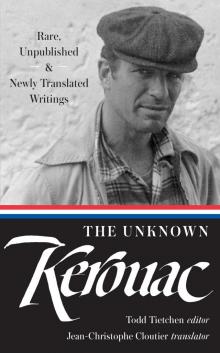 The Unknown Kerouac
The Unknown Kerouac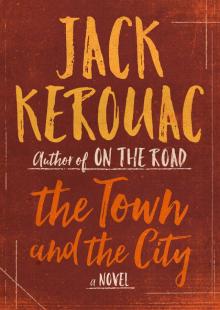 The Town and the City
The Town and the City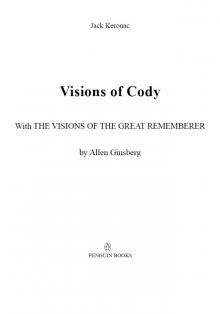 Visions of Cody
Visions of Cody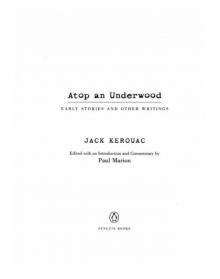 Atop an Underwood
Atop an Underwood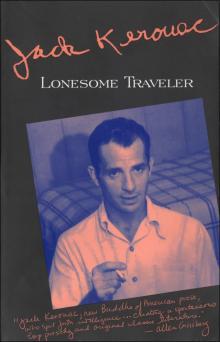 Lonesome Traveler
Lonesome Traveler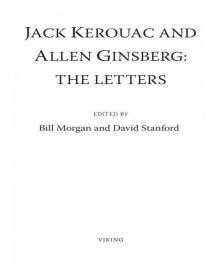 Jack Kerouac and Allen Ginsberg
Jack Kerouac and Allen Ginsberg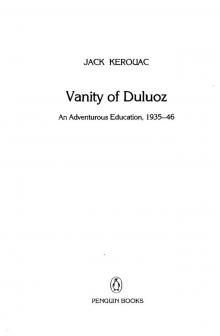 Vanity of Duluoz
Vanity of Duluoz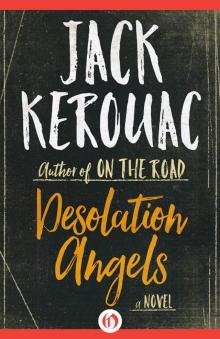 Desolation Angels
Desolation Angels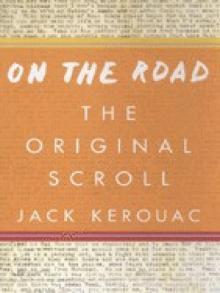 On the Road: The Original Scroll: (Penguin Classics Deluxe Edition)
On the Road: The Original Scroll: (Penguin Classics Deluxe Edition) The Sea Is My Brother: The Lost Novel
The Sea Is My Brother: The Lost Novel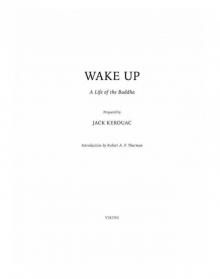 Wake Up
Wake Up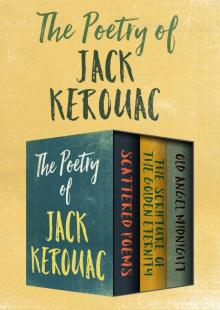 The Poetry of Jack Kerouac
The Poetry of Jack Kerouac Doctor Sax
Doctor Sax